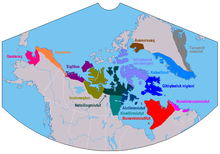Inuktitut is a language of the Arctic, spoken by Inuits in Canada and in Greenland. Inuktitut is a very complex language. It is an official language in Nunavut and the Northwest Territories.
| Inuktitut | |
|---|---|
| Eastern Canadian Inuktitut | |
| ᐃᓄᒃᑎᑐᑦ | |
 Distribution of Inuit languages across the Arctic. East Inuktitut dialects are those east of Hudson Bay, here coloured dark blue (on the south of Baffin Island), red and pink, and the brown in NW Greenland. | |
| Native to | |
| Region | Northwest Territories, Nunatsiavut (Newfoundland and Labrador), Nunavik (Quebec), Nunavut, Alaska |
Native speakers | 39,475 (2016 census)[1] 36,000 together with Inuvialuktun (2006) |
| Dialects |
|
| Inuktitut syllabics, Inuktitut Braille, Latin | |
| Official status | |
Official language in | Nunavut Northwest Territories |
Recognised minority language in | |
| Regulated by | Inuit Tapiriit Kanatami and various other local institutions. |
| Language codes | |
| ISO 639-1 | iu Inuktitut |
| ISO 639-2 | iku Inuktitut |
| ISO 639-3 | iku – inclusive code InuktitutIndividual codes: ike – Eastern Canadian Inuktitutikt – Inuinnaqtun |
| Glottolog | east2534 Eastern Canadian Inuktitut |
| ELP | Inuktitut |

The Inuit write Inuktitut in two ways. One way to write Inuktitut is by using the Roman alphabet. The other way to write Inuktitut is by using an abugida, which is a kind of alphabet which has letters based on syllables.
The Inuktitut syllabary uses a small part of the Unified Canadian Aboriginal Syllabics, a set of letters made up for writing down many of the languages of the First Nations people in Canada.
Some words in English come from Inuktitut or another Inuit language. Among them are the words anorak, igloo, and kayak.
References
change- ↑ "Census in Brief: The Aboriginal languages of First Nations people, Métis and Inuit". Statistics Canada. 25 October 2017. Retrieved 2017-11-12.
Inuktitut edition of Wikipedia, the free encyclopedia